workover rig inspection checklist free sample
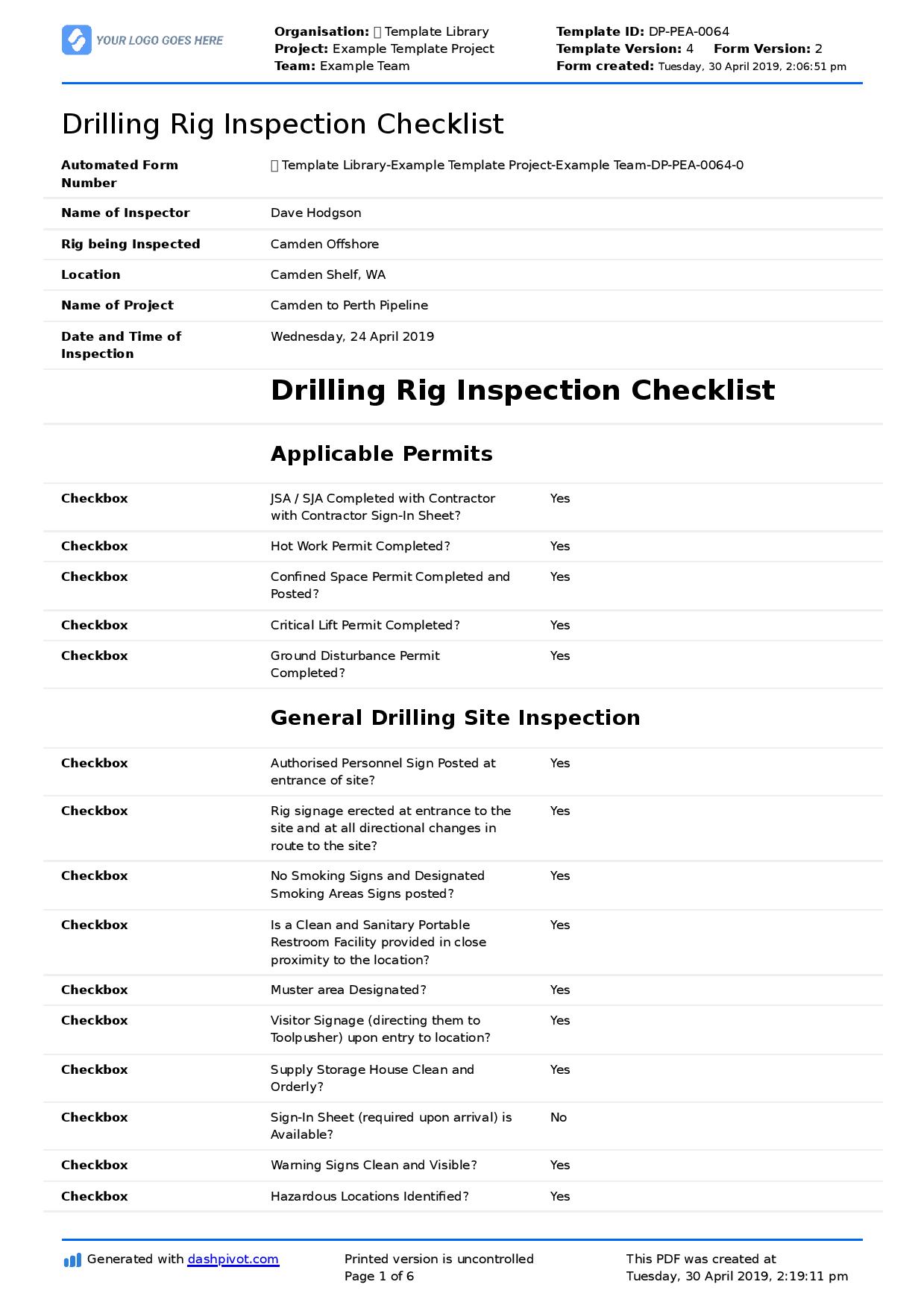
Download Workover & Drilling Rig Inspection Checklist As we mentioned in the Rig Audit Article, rig inspection is an important process that shall be done from time to time. Especially, after the rig moving to a new drilling location.

Rig Check was developed by the National Institute for Occupational Safety and Health (NIOSH) in partnership with safety experts from the oil and gas extraction industry. It is made up of 35 inspection forms. The forms are designed to be used by rig workers to document the inspection of tools and equipment commonly found on rotary and workover rigs. Each inspection form includes instructions for assessing and recording the condition of the equipment. When applicable, relevant federal regulations and industry recommended practices are included.
The Rig Check inspection forms are an excellent training tool for short service employees, who may not be familiar with the tools and equipment found on oil and gas rigs. Small companies whose safety and health resources are limited may find Rig Check useful for enhancing their HSE programs.
Ensure that each well has an emergency response plan, which includes simple instructions for notifications in the event of a rig-based emergency. Notification protocols for medical emergencies, fire on the rig or location, gas release or loss of well control, or a security breach should all be included. In most cases, there will be contingency plans in place for the well that address notifications for long-term events that include notification of government agencies and outside well control expertise. These contingencies can be noted in the working plan but should not complicate the posted action plan.
LOCATIONS: Write locations of posted, current emergency response plans. These should be in central locations such as the rig doghouse, change house, Rig Supervisor’s office, Company Man’s office, and rig camp.
In addition, check that the response plan is posted anywhere emergency communications may be made, including the Rig Supervisor’s truck, and the guard shack.
ALARMS:Rig emergency alarms may be automatic or operated by personnel from various locations manually. Whichever the case, the alarms should be heard throughout the rig and on the location. The alarms should be distinctive and easy to identify as to their purpose. Alarms that work in conjunction with lights should be visible from the entrance of the location. It is a good practice to include a wind direction indicator in close proximity to the lights. All employees should be trained to activate manual alarms and understand what triggers automatic alarms.
DEVICES:Emergency shut-down devices (ESD) that will close off the combustion air should be installed on all of the rig’s diesel engines. It is important to understand just how particular ESD functions BEFORE you attempt to test it. Engine shutdowns or rig savers may damage engine components if they are engaged when the engine is running at speed. Careful plans should be made with the mechanics to develop a test protocol that will ensure the functionality of the devices without damaging the engine. In most cases, these devices can be checked with the engine shut down. Manual engine shutdown devices that shut off the fuel to the engines can also be tested while the engine is shut down.
SMOKE ALARMS:Smoke alarms in trailers and outbuildings should be function tested monthly or following a rig move. Note on the inspection form when batteries are changed each year.
the rig should have a written plan for calibrating and testing alarms and shutdown devices. The inspection should include a review of these documents to ensure new equipment and or rig modifications have not altered the function of the devices.
These checklists are not all inclusive. You may wish to add to them or delete portions that do not apply to your workplace. Carefully consider each item as you come to it and then make your decision. Do not spend time with items that have no application to your workplace.
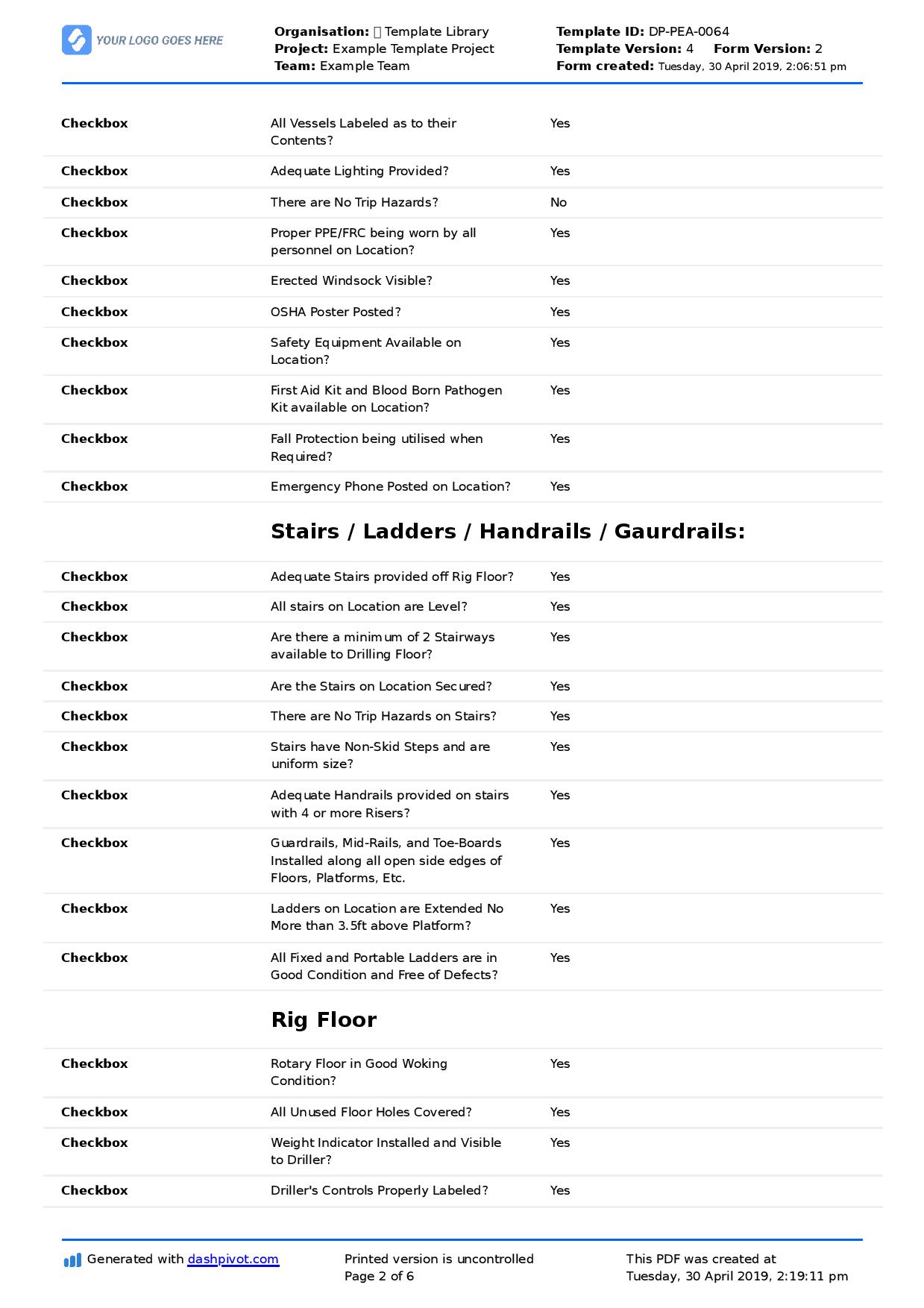
This website is using a security service to protect itself from online attacks. The action you just performed triggered the security solution. There are several actions that could trigger this block including submitting a certain word or phrase, a SQL command or malformed data.

Drilling rigs are some of the most dangerous workplaces or "sites" on Earth. Working on and around a drilling rig introduces many of the most dangerous hazards associated with industrial work including heights, dangerous chemicals, high pressures, explosive materials and more.
To prevent disasters and ensure that everyone working on these rigs does remain safe (and that the reputation of drilling and energy companies remains in tact), companies and workers engage in a number of safety procedures including drilling rig inspections.
These inspections are designed to guide an inspector, auditor or applicable person through a series of checklist questions which have been created to surface any obvious, urgent or problematic issues.
The template comes pre-built with sections for permits, site, stairs and ladders, the rig floor, fuel tanks, electrical systems, material handling and more.
You can also export the resulting checklist report, so that you can make your inspection process nice and efficient while having the convenience of perfectly formatted PDF reports as well.
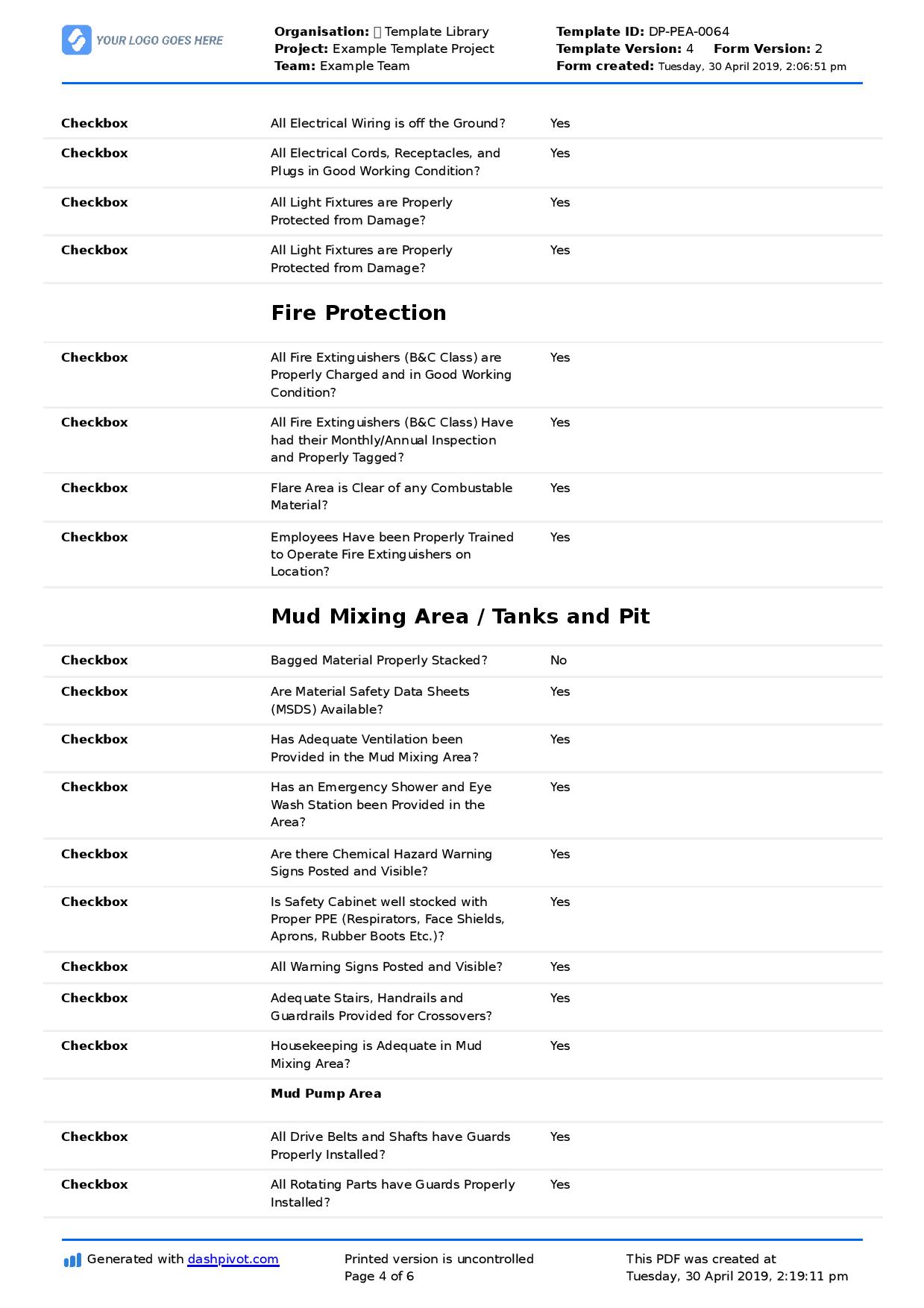
Are you looking for a more convenient way to conduct inspections of drill rigs and drilling equipment? This easy to use app for drilling rigs and drilling rig components makes it easy to complete inspections from anywhere. Simply open a new inspection checklist form using your smartphone or tablet, and you"ll be prompted to inspect the drilling equipment and drill rigs before they are used in the field.
The checklist covers the important safety considerations for land drilling rigs, including checking the drill bit, drill rod, drilling fluid and drill collars for wear and tear and inspecting the drill pipe for erosion. With the app, any drilling company or individual who offers drilling services can quickly and easily perform inspections and save them electronically for their records.

This website is using a security service to protect itself from online attacks. The action you just performed triggered the security solution. There are several actions that could trigger this block including submitting a certain word or phrase, a SQL command or malformed data.

This website is using a security service to protect itself from online attacks. The action you just performed triggered the security solution. There are several actions that could trigger this block including submitting a certain word or phrase, a SQL command or malformed data.

This website is using a security service to protect itself from online attacks. The action you just performed triggered the security solution. There are several actions that could trigger this block including submitting a certain word or phrase, a SQL command or malformed data.
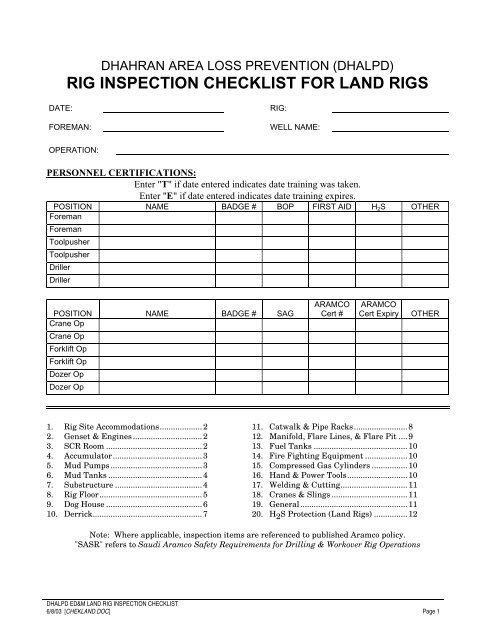
Safety is vitally important on rigs. This app helps keep the operational integrity of land rigs compliant with regulations and standards. It is only a sample of what can be done. It helps identify dangers before they can cause serious damage. Keep records, photos and signatures of approval in one location in a connected or disconnected environment. This rig inspection checklist form can be customized to suit your rigs requirements and regulations on oil and gas rigs, workover rigs, drilling equipment checklists, and other inspection services.Try Template
Fulcrum helps us improve our processes and make our work environment safer by streamlining inspections, surfacing inspection-related insights, and managing follow-up actions. Once you close the loop from action to insight to further action, the possibilities are limitless.

A smooth monthly inspection process through the Drilling Rig Inspection Checklist will help workers and maintain effective safety standards. The downloadable and digitally-storable template covers data on the equipment found before entering the site, including, but not limited to the visibility of emergency and warning signages, clarity of access tracks, accessibility of parked reversed vehicles, and stability of rig set up. The electronic drilling rig inspection checklist also requires information on drilling instrumentation, site housekeeping, rig emissions (dust, water, cutting control), guarding, fluid leaks, fire fighting equipment, first aid equipment, “E” stops and alarms, lighting arrangements, lighting tag out and isolation, equipment inspections, servicing of equipment, and visual inspection, among others.

This website is using a security service to protect itself from online attacks. The action you just performed triggered the security solution. There are several actions that could trigger this block including submitting a certain word or phrase, a SQL command or malformed data.
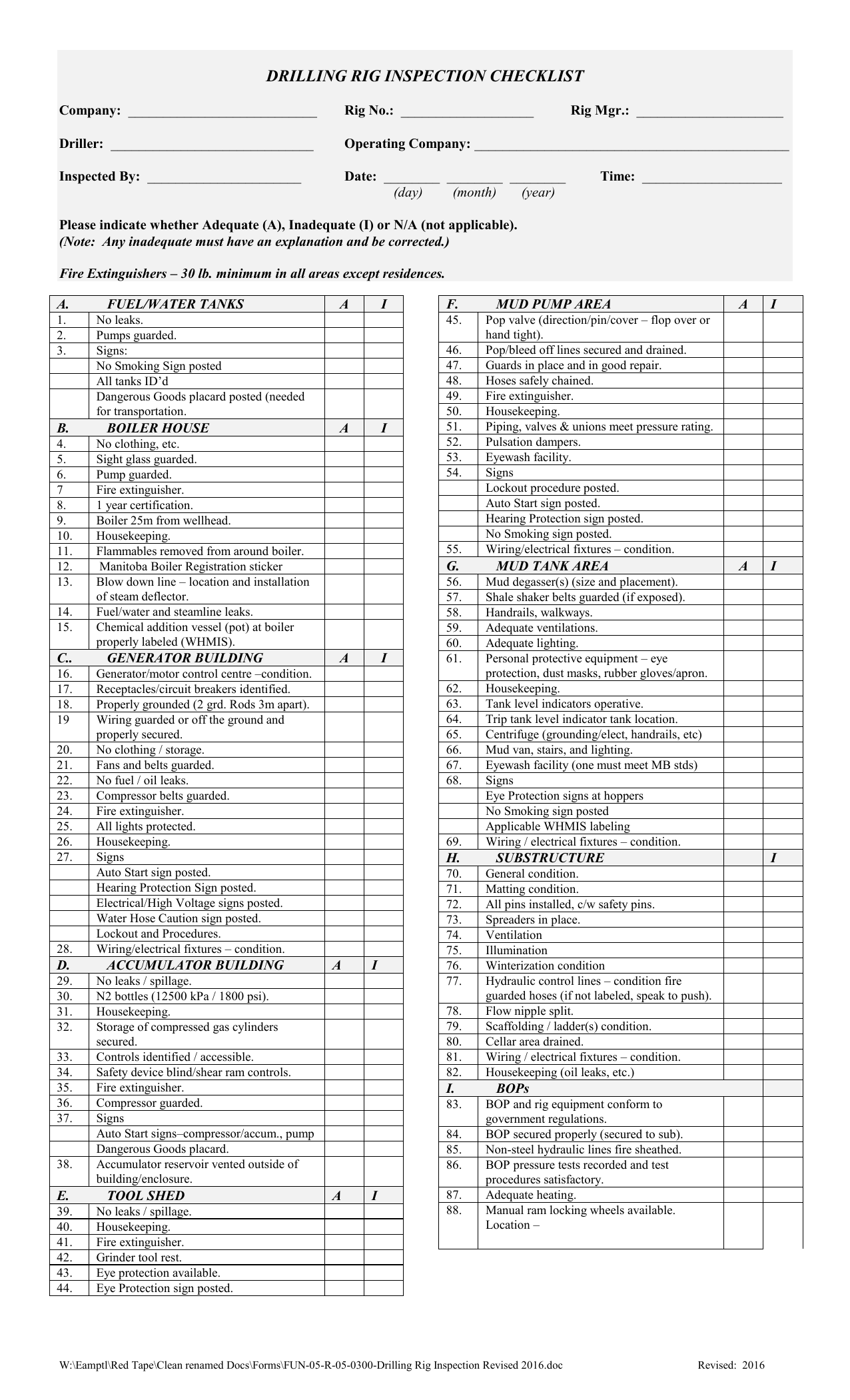
Rig Check was developed by the National Institute for Occupational Safety and Health (NIOSH) in partnership with safety experts from the oil and gas extraction industry. It is made up of 35 inspection forms. The forms are designed to be used by rig workers to document the inspection of tools and equipment commonly found on rotary and workover rigs. Each inspection form includes instructions for assessing and recording the condition of the equipment. When applicable, relevant federal regulations and industry recommended practices are included.
The Rig Check inspection forms are an excellent training tool for short service employees, who may not be familiar with the tools and equipment found on oil and gas rigs. Small companies whose safety and health resources are limited may find Rig Check useful for enhancing their HSE programs.
Ensure that each well has an emergency response plan, which includes simple instructions for notifications in the event of a rig-based emergency. Notification protocols for medical emergencies, fire on the rig or location, gas release or loss of well control, or a security breach should all be included. In most cases, there will be contingency plans in place for the well that address notifications for long-term events that include notification of government agencies and outside well control expertise. These contingencies can be noted in the working plan but should not complicate the posted action plan.
LOCATIONS: Write locations of posted, current emergency response plans. These should be in central locations such as the rig doghouse, change house, Rig Supervisor’s office, Company Man’s office, and rig camp.
In addition, check that the response plan is posted anywhere emergency communications may be made, including the Rig Supervisor’s truck, and the guard shack.
ALARMS:Rig emergency alarms may be automatic or operated by personnel from various locations manually. Whichever the case, the alarms should be heard throughout the rig and on the location. The alarms should be distinctive and easy to identify as to their purpose. Alarms that work in conjunction with lights should be visible from the entrance of the location. It is a good practice to include a wind direction indicator in close proximity to the lights. All employees should be trained to activate manual alarms and understand what triggers automatic alarms.
TESTING ALARMS:Manual alarms can be tested during drills and during crew training sessions. Position crew members around the rig to provide feedback as to coverage and volume of the alarms. Whenever possible, test alarms with test gas to ensure proper calibration and sensitivity. You should never claim a false alarm as a function test.
DEVICES:Emergency shut-down devices (ESD) that will close off the combustion air should be installed on all of the rig’s diesel engines. It is important to understand just how particular ESD functions BEFORE you attempt to test it. Engine shutdowns or rig savers may damage engine components if they are engaged when the engine is running at speed. Careful plans should be made with the mechanics to develop a test protocol that will ensure the functionality of the devices without damaging the engine. In most cases, these devices can be checked with the engine shut down. Manual engine shutdown devices that shut off the fuel to the engines can also be tested while the engine is shut down.
SMOKE ALARMS:Smoke alarms in trailers and outbuildings should be function tested monthly or following a rig move. Note on the inspection form when batteries are changed each year.
the rig should have a written plan for calibrating and testing alarms and shutdown devices. The inspection should include a review of these documents to ensure new equipment and or rig modifications have not altered the function of the devices.
These checklists are not all inclusive. You may wish to add to them or delete portions that do not apply to your workplace. Carefully consider each item as you come to it and then make your decision. Do not spend time with items that have no application to your workplace.
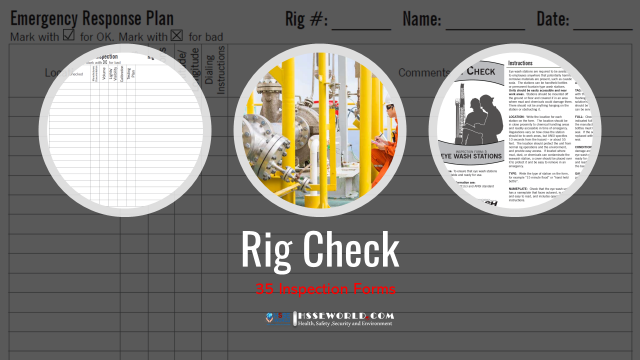
Health and safety in oil and gas natural gas exploration and production is possible with the rightequipment checklistsand work ethic by the crew members, even with the increased use of risky hydraulic fracturing technologies by shale gas producers.
Rig checks are important for safety because they are an effective tool to reduce serious injuries and fatalities in the oil and gas industry. Having the ability to identify any unsafe conditions or practices on rigs and take prompt corrective actions. They also help to control costs associated with production delays and rig repairs, insurance costs and lost production due to shut-downs. Rig checks are essential for the safe operation of oil and gas facilities and associated equipment to minimize the risk of fires, explosions, falls, and other injuries. They ensure that equipment is properly maintained and ready for safe use.
Rig checks are conducted by the rig management team once per shift during the pre-operational inspection (POI) and once per shift during the operational inspection (OOI). It is a systematic review to evaluate and document conditions, including equipment, work practices, and procedures. During a rig check, the rig management team members review the status of each rig system and component and check their condition. They examine the gear to ensure it is clean, undamaged, and in serviceable condition. They also check the condition of electrical and mechanical systems and their safety devices.
The Oklahoma Rig Explosion is the deadliest oil and gas disaster since Deepwater Horizon. The 2018 explosion near Quinton, Oklahoma, occurred when gas escaped from an oil well, ignited, and killed five workers.
An investigation by the US Chemical Safety Board found several causes of the accident, key among them being a failure to conduct critical safety inspections and an overall lack of adequate safety management. For more than 14 hours before the explosion, dangerous conditions were building up in the well but seem not to have been identified or effectively communicated by oil workers.
To address the need for rig safety inspections Rig Check was developed by the National Institute for Occupational Safety and Health (NIOSH) in partnership with safety experts from the oil and gas extraction industry. It is made up of 35 inspection forms.
Each inspection form includes instructions on how to assess and record the condition of equipment and other relevant items for your operation by rig workers.
Many oil and gas producers still use antiquated manual methods to perform inspections and communicate issues. Below is the typical day of an inspector:
To improve issue communication, oil and gas companies must turn to digital inspection and communication methods. Digital communication technologies help companies develop more efficient communication, remote monitoring, and real-time asset management on oil rigs and oil fields.
Enter the FTQ360’s NIOSH Rig Inspection checklists to the modern world of cloud-based mobile technologies. While maintaining backward compatibility to the NIOSH recommendations, FTQ360 has extended the capabilities to integrate photo documentation, dynamically expanding to verify each check made, and to document deficiencies that require correction.
Ladders and Platforms: ensure that ladders and platforms around the rig are of the proper size and configuration required to provide safe access for employees.
The FTQ360 Oil and Gas Software Platform is a quality management tool for oil and gas that helps companies conduct inspections while streamlining communications and sticking to industry recommended practices.
Stay on top of your deficiencies by eliminating unnecessary steps and automating critical tasks. Defects are documented right on the inspection checklist screen.




 8613371530291
8613371530291